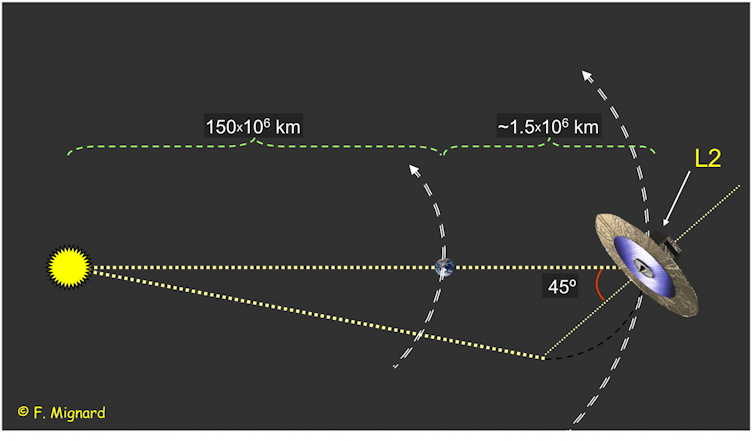Gaia’s orbit around the Lagrange point L2 was carefully chosen from the point of view of its stability, both thermal and gravitational. The L2 Lagrange point is one of the quasi-stable equilbrium points of the Sun-Earth system.
At this point, the centrifugal force is balanced by the combined attractive forces of the Earth and the Sun.
This point is 1.5 million km beyond the Earth, on the Sun-Earth line, and it turns around the Sun with the same period as the Earth. Thus, Gaia will follow the motion of the Earth around the Sun for about 5 or 6 years, while maintaining a constant inclination of 45∞ with respect to the Sun.
Each loop will take 6 months to complete : the satellite will thus pass successively above and below the orbital plane of the solar system, slightly ahead or behind the Earth. The final size of the Lissajous will be 263 000 x 707 000 x 370 000 km. By following these large loops, Gaia will avoid passing through the Earth’s shadow, which would cut off the solar radiation needed to furnish electricity, and which would engender violent changes in temperature. Position of the first L2 Lissajous around L2
Note that in these figures (adapted from © ESA), the distance between the Earth and Gaia has been significantly exaggerated for clarity.
The Earth is about 150 million km from the Sun (the exact distance depending on the orbital position of the Earth).
The distance between the Earth and Gaia is roughly 100 times smaller.
A number of crucial steps had to be crossed to reach this stage :
- On December 19th 2013 (see the details of the first two hours into the flight) :
- a perfect launch by the sixth Soyouz-Fregat rocket from the Guyana Space Centre, Europe’s space port in French Guyana ;
- a quick tour around the Earth at an altitude of 175 km, on a ´ parking ª orbit ;
- separation of Gaia from the Fregat stage of the launcher : 43 minutes after launch, Gaia was on its own ;
- ground-Gaia communication systems activated.
- On December 20th 2013 :
- Gaia’s solar panels turned towards the Sun : in its final configuration, Gaia’s rotation axis is inclined at 45 degrees with respect to the Sun
- first burn of Gaia’s rockets, a delicate operation which sent Gaia towards the L2 Lagrange point.
- On December 30th 2013, a calibration burn preparatory to ignition on January 7th.
- On January 7th 2014, at 19h 58 Paris time, ignition of five of Gaia’s eight rockets for exactly 103 minutes : a crucial
- maneeuvre needed to send Gaia towards its orbit around the L2 point.
- The rockets’ impulse and direction required complex orbital calculations as well as a detailed analysis of Gaia’s dynamics : 2013kg had to be sent from a terrestrial transfer orbit to the Lissajous around L2,
- while carefully maintainng the instruments in the shadow of the heat shield.
- On January 10th 2014, the rotation of the satellite was interruped preparatory to final injection into the orbit arund L2. Rotation was restarted on January 15th.
- On January 13th 2014, the software for this latter manoeuvre was loaded into the on-board computer.
In future, one "shot" of cold gas per month will suffice to maintain Gaia on station.
So that Gaia’s delicate instruments and their measurements are not affected,
these "shots" are of course very weak : 49 such shots would be needed to raise an A4 sheet of paper weighing 5g !
The following diagrams (figure © F. Mignard, animation © ESA) show the orientation of Gaia
with respect to the Sun, and the motion of a satellite at this Lagrange point.
Note that in these figures, as in the previous ones, the Earth-Gaia distance has been significantly exaggerated for clarity.
Gaia at L2



